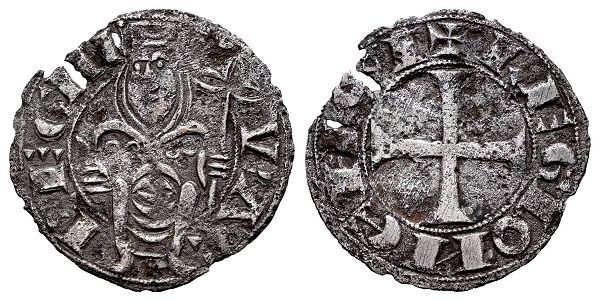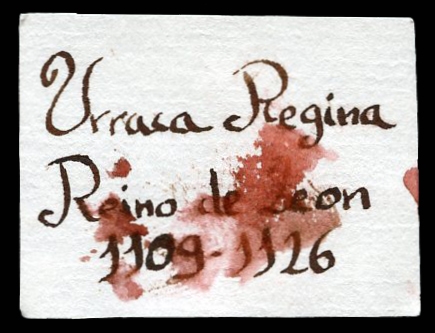
“Doña Urraca” — By Manuel Mozo Monroy
It was at the very beginning of October 2018 when we had news of the appearance of a second dinero of this type (Urraca of León), which was purely a essentially different variant from the only known specimen.
According to the reliable information that we get on that coin, this specimen came from a Numismatic shop in Foix, in the South of France.

Floor Auction 30 – 29/05/2019. Lot 280. Click here to see this lot.
Kingdom of Castille and Leon. Doña Urraca (1109-1126). Dinero. (Vq-14). (Mozo-U1:9.1). Obv.: VRAC REGIN. Rev.: +LEGIONENSI. Ae. 0,54 g. Minor edge fault, otherwise specimen of the highest rarity.
This piece represents once more, the queen sitting in a lineal throne, showing very subtle and interesting slight differences over the first discovered dinero.
The outlines of the queen’s picture, with a childish feature in her barely stippled face. The headcloth is completely squared and made by straight lines inside. The tunic is floor-length, and the veil that covers her head it´s much more evident.
Hands, in this occasion, are small and barely wrought with schematic lines, carries – one of them-, a branch called “of virtue”, while the other hand -which in the first known specimen had out of proportion dimensions- adopts similar position, but with more restricted handiwork.
” It comes very difficult –impossible nowadays- to affirm if this second specimen discovered and revealed in time, it´s or not the same coin that Campaner saw, but the truth is that we harbor deep suspicious that it´s so. “
As can be observed, the differences between them are minimum, but what can be affirmed is that we are dealing with a different die from the first piece photographed.
It comes very difficult –impossible nowadays- to affirm if this second specimen discovered and revealed in time, it´s or not the same coin that Campaner saw, but the truth is that we harbor deep suspicious that it´s so.
It´s well known that many of the most eminent numismatic collections from Catalonia and Valencia left the Iberian Peninsula on their way to the French neighbor country, at the beginning of the Spanish Civil War, and nothing prevents that this was another case of it.

Little manuscript cardboard that accompanies the piece. It could have been written by Josep Vives i Ciscar.
Given that we don´t have argumentative proof that this dinero has been found by chance or in purpose in Spanish territory, bond to its ultra-Pyrenean origin, makes us to trust in this wild guess, that both specimens, – Campaner and Foix-are the same piece.
The only thing that unsettles us is that the inscription that the writer from Mallorca thought to read: “+ LEGIOES ET C”- has nothing to do with the clear “+ LEGIONENSI” that appears on this one’s reverse. For us it´s hard to believe that Campaner had a mistake so obvious and big in the interpretation of this motto.
However, in that moment and whatever it was, our opinion is that as long as we didn´t get more information about it, this piece should remain as the one which seemed to be with the most probability, the firm candidate to have been part of the old collections of Cerdá of Villarestán and Vives and Ciscar.
Manuel Mozo Monroy




